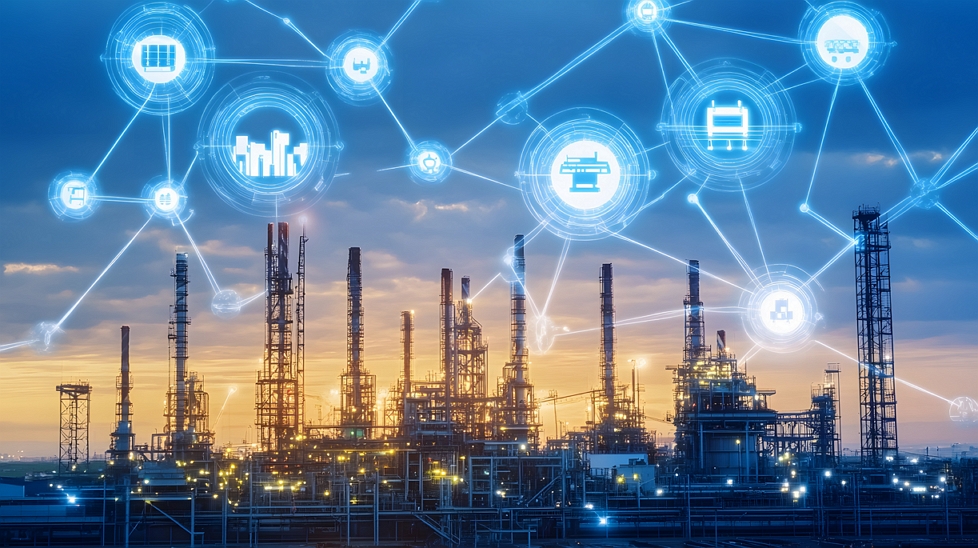#Introduction to IoT in Oil and Gas
The Internet of Things (IoT) refers to the network of physical devices, ranging from sensors and machines to vehicles and infrastructure that are connected to the internet; allowing them to collect, share, and analyse data in real time.
These devices communicate with each other and with central systems, enabling smarter decision-making, predictive analytics, and automated responses.
In the midstream oil and gas industry, IoT is transforming traditional operations by bridging the gap between remote field equipment and centralised data systems. From exploration and drilling to production, refining, and distribution, IoT technologies offer unprecedented visibility and control over every phase of the value chain.
Given the complexity, scale, and often hazardous environments of oil and gas operations, real-time monitoring and automation are critical. IoT enables companies to track equipment health, monitor environmental conditions and optimise resource usage.
IoT helps cut costs by enhancing safety protocols and reducing downtime. As it connects field operations to the cloud, IoT allows stakeholders to make faster, data-driven decisions, manage assets remotely, and improve operational efficiency.
As digital transformation accelerates, the adoption of IoT in midstream oil and gas is no longer a futuristic vision; it's an essential component of building more resilient, agile and sustainable energy operations.
#IoT for Remote Monitoring
One of the most impactful applications of IoT in the midstream oil and gas industry is remote monitoring. With assets often spread across vast, hard-to-reach locations, being able to track conditions and performance in real time is a game-changer.
IoT-enabled sensors and smart devices are deployed on critical infrastructure such as pipelines, compressors, pumps, storage tanks, and drilling equipment. These sensors continuously collect data on variables like pressure, temperature, vibration, flow rate, equipment status, and even environmental factors such as weather or seismic activity.
This real-time data is transmitted to centralised systems or cloud platforms via secure communication networks. Operations teams and decision-makers can then access dashboards, alerts, and analytics from virtually anywhere, such as on-site, at a central office, or on a mobile device.
IoT-based remote monitoring offers key benefits such as the following:
IoT systems can detect anomalies that signal potential equipment failure, helping prevent unplanned downtime and costly repairs.
Monitoring for gas leaks, pressure irregularities, or unauthorised access enhances worker and environmental safety.
Remote monitoring minimises the need for personnel to travel to dangerous or distant sites, cutting operational risks and costs.
Real-time data supports regulatory compliance by tracking emissions, fluid levels, and operational thresholds.
Ultimately, IoT turns traditional reactive maintenance into a proactive and predictive strategy, boosting reliability and maximising uptime across the entire midstream oil and gas ecosystem.
#Cloud Integration
As IoT devices generate vast amounts of data from across midstream oil and gas operations, the cloud plays a critical role in storing, processing, and leveraging that information.
Integrating IoT data with cloud platforms allows companies to analyse insights at scale, enabling smarter, faster and more coordinated decision-making.
With cloud integration, data from remote sensors, machinery and control systems is transmitted securely to centralised cloud environments where it's accessible to both field teams and headquarters.
Here’s how cloud integration adds value:
The cloud can process incoming IoT data immediately, enabling real-time dashboards, alerts, and visualisations that support quick decisions and rapid responses.
All operational data is unified in a single platform, breaking down silos and improving data accuracy and consistency.
Cloud platforms often support artificial intelligence and machine learning tools that can analyse trends, predict failures, optimise performance, and automate workflows.
Cloud systems can grow with operational needs, making it easy to add new IoT devices, increase storage, or expand to new sites without major infrastructure changes.
By connecting the field to the cloud, midstream oil and gas companies gain a real-time view of operations, from individual assets to the entire supply chain. This integration lays the foundation for a truly digital, data-driven midstream oil and gas enterprise.
#Benefits of IoT and Cloud Integration
The convergence of IoT and cloud technologies offers transformative benefits for the midstream oil and gas industry. By connecting field devices to centralised cloud platforms, companies can unlock deeper insights, faster decision-making, and more agile operations.
Here are some of the key advantages:
1. Improved Safety
Real-time monitoring enabled by IoT sensors helps identify safety hazards before they escalate. Whether it’s detecting gas leaks, abnormal pressure levels, or equipment malfunctions, automated alerts and remote visibility empower teams to respond quickly; often without needing to enter hazardous environments physically.
2. Predictive Maintenance
Traditionally, maintenance has followed fixed schedules or responded to failures after they occur. IoT changes this by enabling predictive maintenance. By continuously monitoring asset health and performance trends, companies can anticipate equipment issues and schedule repairs proactively, reducing downtime and extending asset life.
3. Enhanced Operational Efficiency
With cloud-based access to IoT data, decision-makers can oversee entire operations from a centralised dashboard. This visibility streamlines workflows, optimises resource allocation, and minimises the need for manual data collection or on-site inspections.
4. Cost Reduction
Fewer equipment failures, optimised maintenance schedules, and reduced manual intervention translate directly into cost savings. In addition, by improving asset utilisation and energy efficiency, IoT and cloud integration help reduce both operating expenses (OPEX) and capital expenditures (CAPEX).
#Future Trends and Innovations
As digital transformation continues to gain momentum, the fusion of IoT and cloud technologies is poised to reshape the midstream oil and gas industry even further. Emerging innovations promise to drive smarter, more autonomous, and more sustainable operations across the energy value chain.
Here are some key trends to watch:
1. Edge Computing for Faster Decisions
While cloud platforms handle massive data analysis, edge computing (processing data locally at the source) will become more common. This hybrid model allows for real-time decision-making in remote or latency-sensitive environments, reducing the need to send every data point to the cloud.
2. AI and Machine Learning Integration
The next wave of efficiency will come from advanced AI and machine learning (ML) models built into cloud platforms. These tools will not only predict equipment failures but also optimise drilling parameters, forecast energy demand, and automate repetitive tasks, leading to self-adjusting operations with minimal human intervention.
3. Increased Focus on Sustainability
With growing environmental pressures, IoT will play a bigger role in monitoring emissions, managing waste, and improving energy efficiency. Cloud-based analytics will help companies meet regulatory requirements and track ESG (Environmental, Social, Governance) performance in real time.
4. Autonomous and Robotic Systems
IoT-enabled drones, robots, and autonomous vehicles will increasingly support inspection, surveillance, and even maintenance in dangerous or inaccessible locations. These systems will rely heavily on cloud processing and real-time data exchange to function effectively and safely.
5. Cybersecurity Enhancements
As the digital footprint expands, cybersecurity will be a top priority. Expect to see more investment in AI-driven threat detection, secure IoT device protocols, and end-to-end encryption to protect critical infrastructure from evolving cyber threats.
The future of the midstream oil and gas sector lies in connected, intelligent operations. By continuing to embrace IoT and cloud innovations, energy companies can not only boost efficiency and safety but also become more agile and sustainable in a rapidly changing global landscape.




